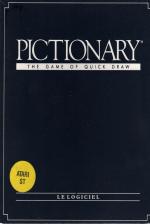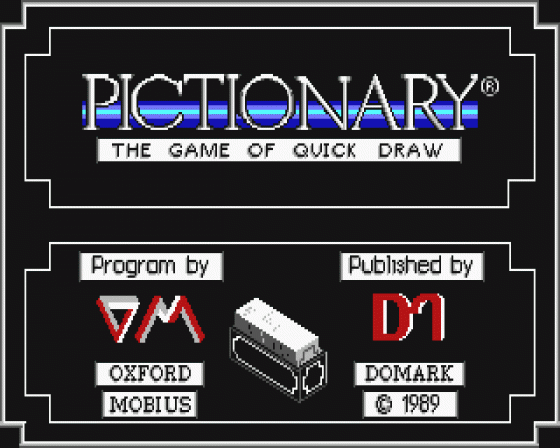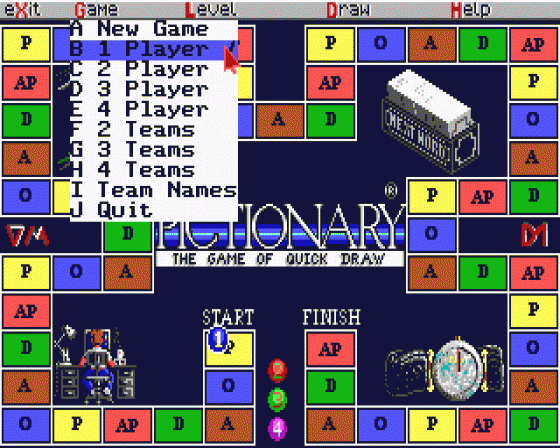
ST Format
 1st February 1990
1st February 1990
Categories: Review: Software
Author: Steve Carey
Publisher: Domark
Machine: Atari ST
Published in ST Format #6
Pictionary
Domark have a clear and successful strategy of balancing "fast" games with "slow" ones. The former are their frantic but shortlived arcade conversions - such as Toobin' and Hard Drivin'; the latter are slow burners such as Trivial Pursuit and now Pictionary. A penny gets you a pound Xybots and Dragon Spirit crop up on compilations some time in the next year: a pound gets you a hundred Pictionary won't, and will still be selling steadily three years from now.
Pictionary, if you're not familiar with the board game, is simply charades on paper. You draw, your teammates guess and the opposition howl derisively. It's a laughably simple idea: it's also been massively successful, selling some fifteen million board games in the States.
What's fun about the board game is the gulf between the drawer's conviction that what's on paper could be guessed by any fool - and the rest of the team's frustration at the complete inscrutability of the doodle.

Multiply this gulf a hundred times and you have Pictionary, the ST game. The object is to identify, through clues sketched on the screen, a word taken from one of five categories: person, place or animal; object, action; a group of difficult words; and words taken from any category.
There are two ways to play. The computer draws the word, and you (and your team, if you play in groups) attempt to guess. Alternatively, you can do the drawing for yoursef, using the built-in drawing program. With it you can draw straight, curved and freehand lines, boxes, circles and ellipses and fill designated areas with a selection of patterns and inks.
For those who've used Degas Elite or Spectrum 512 this junior art package is tame stuff. But if you've ever used your ST as a games machine, it makes a fine introduction to stuff you've been missing out on.

Drawing onscreen, though, is one almighty pain to learn. It is so frustrating to find that when you have in your mind just won't appear on the screen. You may find as I did that you set out to draw one thing - a church, say, complete with steeple - and find halfway through that you're well on the way to creating a reasonably convincing frog or banana.
Pictionary is definitely in that category of software more bought for than by its owner. But if you wake up on Christmas morning (bah humbug) to find that box looks suspiciously like Pictionary, don't despair. Clear the house, call up a few of your rowdier mates, stock up on the tubes and Tortilla chips, put your money where your mouth is and get down to some serious aggro. "That's a what? A truncheon? What kind of sick mind you got, pal? If that's a truncheon I'm Yehudi Menuhin and you're my cat Eric!" That kind of thing.
Effects
I have a lot of time for Domark's care in converting titles, both arcade and otherwise, and I like what they've done with Pictionary. To anyone who knows what GEM is and has ever done anything as advanced as copying files it's a cinch to pick up. Graphics are hardly spectacular and the drawing program wouldn't win awards as a standalone, but then again you don't need flashy distractions, and a simple picture is all you want to produce anyway. The sound, mercifully, can be switched off: there's a wretchedly cheerful oooopp! noise that accompanies fills I would not want to inflict even on Kylie.
One observation: the manual and list of 2,500 words is printed in a size that makes Lawyer Smallprint look like a Sun headline.
Verdict
It's no good anyone trying to pretend that Pictionary is the birth of the cool, and if it's joystick wrist you're after you've come to the wrong place. But it could well surprise you. And in the right company you might even get into a fight over it - which I don't think you could say about Xybots or Dragon Spirit.
Scores
Atari ST Version| Graphics | 70% |
| Sound | 20% |
| Intelligence | 80% |
| Instant Appeal | 60% |
| Lastability | 60% |
| Overall | 72% |






